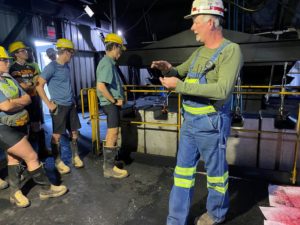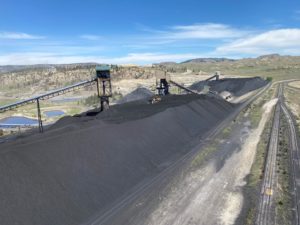 Standing on top of the Signal Peak coal mine tipple—the 10-story chute that loads coal into train cars—you could see almost the entire production area: the mouth of Montana’s only underground coal mine, acres of inventoried coal and the maze of conveyor belts that moves coal from place to place. It has a huge environmental impact. It has a large social and economic impact as well.
Standing on top of the Signal Peak coal mine tipple—the 10-story chute that loads coal into train cars—you could see almost the entire production area: the mouth of Montana’s only underground coal mine, acres of inventoried coal and the maze of conveyor belts that moves coal from place to place. It has a huge environmental impact. It has a large social and economic impact as well.
Almost 300 people make a living at the plant, sending coal to Asia to fuel a world built on almost two centuries of mass coal extraction, refinement and transportation. Four of those workers served as our guides as we toured the surface parts of the mine.
We toured the mine on Day 6 of our class. We were in full force as we rode through the rolling hills of eastern Montana along wildlife and the cars of workers rolling into the Signal Peak mine. It was a pleasant day for riding with moderate hills, favorable winds and high morale because of the enthusiasm our group has for earning our credits under the big sky and learning what it will take to instill systemic change to create a world without coal or other fossil fuels.
The immensely complicated, technically precise and efficient coal mine showed us just what society has been capable of building, and asks how we will use our ingenuity to build our way out of the climate impacts fossil fuel consumption has had on the planet. Meeting the mine workers who showed us around put faces onto the question of what that move away from coal will mean for the workers whose livelihoods stem from fossil fuel production.
Coal mining pits the need to supply the industrial and residential electricity needs of the world against the stability of Earth’s climate. This particular mine in Roundup exports over seven million tons of coal to Japan, China, South Korea and Thailand every year, which shows just how efficient we are at digging up this valuable rock.

The mine spends $1 million each month on electricity to run its 24/7 production. Even though it provides just a small fraction of the coal that those countries will use, it still takes an incredible amount of innovation, energy and negotiating to export coal mined here. The expansive conveyor belt systems and everything in between at this mine have to be done by workers who know exactly what they’re doing for up to 12 hours a day.
When we first met these workers, they seemed to have their shields up as if we were going to grill them about environmental issues upon our arrival, but they were lowered by the end once they gradually started to realize that we were there to understand their hardy, hometown culture.
They shared with us a heavy desire to support their families and stay in their hometown, or the town they’ve come to call home. Some miners have come West seeking work after the underground mines they trained in shut down or reduced the number of jobs they support.
As we turned in our hard hats and heavy boots, I saw a kid who is probably about as old as I am walk out with black dust all over his face. It drove home for me how hard these guys work—the sacrifices they make—to support their communities and families. Their lives are very different from mine. They see their lives within their town whereas I feel we are looking outward, studying on this trip the connectivity between different scientific, social, governmental and economic systems. They have a lot going on at the mine—they all know so much about what their jobs entail and how the mine works. It’s very complex and efficient, and all jobs are crucial to keeping everyone safe and productive within each system.
As we were sitting in a meeting room before our tour, a top company administrator popped into the room. Without our prompting, he shot down the idea that we can live without coal, or that we need to. There is no good proof that carbon dioxide emissions are tied to global temperature change, he said.
Of all the good intentions from the people we met at this place, we had to acknowledge that they were there for a cause greater than their own; their jobs aren’t going anywhere if it’s up to a company chief who doesn’t see a need for change.
As we rode to the mine we spotted a coyote and a few pronghorn chasing each other a ways off of the road as if they were fighting back and forth. If the coyote was trying to lure a pronghorn back to the pack, it wouldn’t have happened. Over time the pronghorn is simply built to be able to outrun any predators it faces. I wonder if pronghorn weren’t managed by predators and hunting pressure, if they would continue to take over the ecosystem until nothing was left for other animals grazing the prairie. Similarly, without checks and balances, coal mines will continue to feed our fossil fuel energy economy until nothing is left.
The complex production facility at the mine shows the power of ingenuity in America. It would be a less complicated problem if we could just shift over to renewable energy through changes that Americans agreed on culturally and politically, and if those changes could provide for today’s mine workers.
We were feeling a little flat as we left, knowing this place may continue to operate until it runs out of coal in 2034. Only real and just systemic and cultural change will alter that, which will be quite the task. We picked up our bikes and pumped our tires to pursue our next destination, one we hope is full of inspiration and the clean energy ingenuity that we are starting to realize we are capable of.
Ben Carlson is from Breckenridge, Colorado. He attends Montana State University where he is majoring in Environmental Studies.
3 Replies to “Under the Signal Peak Coal Mine By Ben Carlson”
Comments are closed.
A very well thought-out and written observation
Very informative, Thank you for your interest in the environment.
Thank you for taking the time to understand where we get our energy from, explaining it to us, and caring about the people behind the jobs.